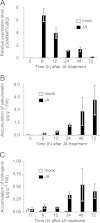Purification and identification of naringenin 7-O-methyltransferase, a key enzyme in biosynthesis of flavonoid phytoalexin sakuranetin in rice
- PMID: 22493492
- PMCID: PMC3365963
- DOI: 10.1074/jbc.M112.351270
Purification and identification of naringenin 7-O-methyltransferase, a key enzyme in biosynthesis of flavonoid phytoalexin sakuranetin in rice
Abstract
Sakuranetin, the major flavonoid phytoalexin in rice, is induced by ultraviolet (UV) irradiation, CuCl(2) treatment, jasmonic acid treatment, and infection by phytopathogens. It was recently demonstrated that sakuranetin has anti-inflammatory activity, anti-mutagenic activity, anti-pathogenic activities against Helicobacter pylori, Leishmania, and Trypanosoma and contributes to the maintenance of glucose homeostasis in animals. Thus, sakuranetin is a useful compound as a plant antibiotic and a potential pharmaceutical agent. Sakuranetin is biosynthesized from naringenin by naringenin 7-O-methyltransferase (NOMT). In previous research, rice NOMT (OsNOMT) was purified to apparent homogeneity from UV-treated wild-type rice leaves, but the purified protein, named OsCOMT1, exhibited caffeic acid O-methyltransferase (COMT) activity and not NOMT activity. In this study, we found that OsCOMT1 does not contribute to sakuranetin production in rice in vivo, and we purified OsNOMT using the oscomt1 mutant. A crude protein preparation from UV-treated oscomt1 leaves was subjected to three sequential purification steps, resulting in a 400-fold purification from the crude enzyme preparation. Using SDS-PAGE, the purest enzyme preparation showed a minor band at an apparent molecular mass of 40 kDa. Two O-methyltransferase-like proteins, encoded by Os04g0175900 and Os12g0240900, were identified from the 40-kDa band by MALDI-TOF/TOF analysis. Recombinant Os12g0240900 protein showed NOMT activity, but the recombinant Os04g0175900 protein did not. Os12g0240900 expression was induced by jasmonic acid treatment in rice leaves prior to sakuranetin accumulation, and the Os12g0240900 protein showed reasonable kinetic properties to OsNOMT. On the basis of these results, we conclude that Os12g0240900 encodes an OsNOMT.
Figures







Similar articles
-
The potential bioproduction of the pharmaceutical agent sakuranetin, a flavonoid phytoalexin in rice.Bioengineered. 2012 Nov-Dec;3(6):352-7. doi: 10.4161/bioe.21546. Epub 2012 Aug 16. Bioengineered. 2012. PMID: 22895058 Free PMC article.
-
Natural variation in the expression and catalytic activity of a naringenin 7-O-methyltransferase influences antifungal defenses in diverse rice cultivars.Plant J. 2020 Mar;101(5):1103-1117. doi: 10.1111/tpj.14577. Epub 2019 Nov 18. Plant J. 2020. PMID: 31630460
-
OsMYC2, an essential factor for JA-inductive sakuranetin production in rice, interacts with MYC2-like proteins that enhance its transactivation ability.Sci Rep. 2017 Jan 9;7:40175. doi: 10.1038/srep40175. Sci Rep. 2017. PMID: 28067270 Free PMC article.
-
Phenolic Phytoalexins in Rice: Biological Functions and Biosynthesis.Int J Mol Sci. 2015 Dec 7;16(12):29120-33. doi: 10.3390/ijms161226152. Int J Mol Sci. 2015. PMID: 26690131 Free PMC article. Review.
-
Sakuranetin and its therapeutic potentials - a comprehensive review.Z Naturforsch C J Biosci. 2022 Jul 13;78(1-2):27-48. doi: 10.1515/znc-2022-0024. Print 2023 Jan 27. Z Naturforsch C J Biosci. 2022. PMID: 35844107 Review.
Cited by
-
Integrated metabolomic and transcriptomic profiling reveals the tissue-specific flavonoid compositions and their biosynthesis pathways in Ziziphora bungeana.Chin Med. 2020 Jul 16;15:73. doi: 10.1186/s13020-020-00354-6. eCollection 2020. Chin Med. 2020. PMID: 32695217 Free PMC article.
-
Disease resistance conferred by components of essential chrysanthemum oil and the epigenetic regulation of OsTPS1.Sci China Life Sci. 2023 May;66(5):1108-1118. doi: 10.1007/s11427-022-2241-0. Epub 2022 Dec 1. Sci China Life Sci. 2023. PMID: 36462108
-
Accumulation of 9- and 13-KODEs in response to jasmonic acid treatment and pathogenic infection in rice.J Pestic Sci. 2018 Aug 20;43(3):191-197. doi: 10.1584/jpestics.D18-022. J Pestic Sci. 2018. PMID: 30363135 Free PMC article.
-
Genome-wide association analyses provide genetic and biochemical insights into natural variation in rice metabolism.Nat Genet. 2014 Jul;46(7):714-21. doi: 10.1038/ng.3007. Epub 2014 Jun 8. Nat Genet. 2014. PMID: 24908251
-
Analysis on blast fungus-responsive characters of a flavonoid phytoalexin sakuranetin; accumulation in infected rice leaves, antifungal activity and detoxification by fungus.Molecules. 2014 Aug 4;19(8):11404-18. doi: 10.3390/molecules190811404. Molecules. 2014. PMID: 25093982 Free PMC article.
References
-
- Koga J., Shimura M., Oshima K., Ogawa N., Yamauchi T., Ogasawara N. (1995) Phytocassanes A, B, C, and D, novel diterpene phytoalexins from rice, Oryza sativa L. Tetrahedron 51, 7907–7918
-
- Koga J., Ogawa N., Yamauchi T., Kikuchi M., Ogasawara N., Shimura M. (1997) Functional moiety for the antifungal activity of phytocassane E, a diterpene phytoalexin from rice. Phytochemistry 44, 249–253
-
- Yajima A., Mori K. (2000) Synthesis and Absolute Configuration of (−)-Phytocassane D, a diterpene phytoalexin isolated from the rice plant, Oryza sativa. Eur. J. Org. Chem. 21, 4079–4091
-
- Akatsuka T., Kodama O., Sekido H., Kono Y., Takeuchi S. (1985) Novel phytoalexins (oryzalexins A, B, and C) isolated from rice blast leaves infected with Pyricularia oryzae. Part I: Isolation, characterization, and biological activities of oryzalexins Agric. Biol. Chem. 49, 1689–1694
Publication types
MeSH terms
Substances
Associated data
- Actions
LinkOut - more resources
Full Text Sources
Molecular Biology Databases
Miscellaneous

